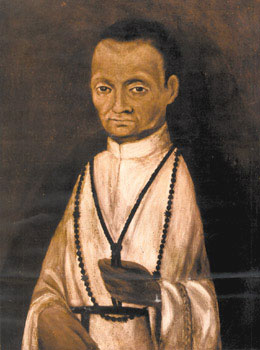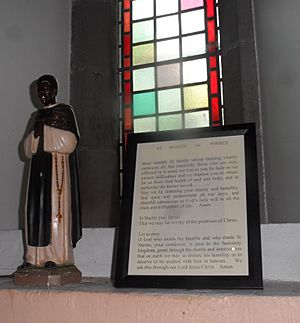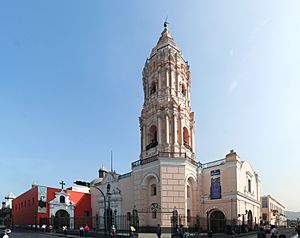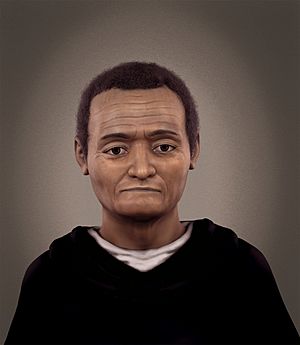Martin de Porres facts for kids
Quick facts for kids SaintMartin de Porres OP |
|
|---|---|

Portrait of St. Martin de Porres, c. 17th century, Monastery of Rosa of Santa Maria in Lima. This portrait was painted during his lifetime or very soon after his death, hence it is probably the most true to his appearance.
|
|
| Martin of Charity Saint of the Broom |
|
| Born | 9 December 1579 Lima, Viceroyalty of Peru |
| Died | 3 November 1639 (aged 59) Lima, Viceroyalty of Peru (modern-day Peru) |
| Venerated in | Roman Catholic Church, Lutheran Church, Anglican Communion |
| Beatified | 29 October 1837 by Pope Gregory XVI |
| Canonized | 6 May 1962, by Pope John XXIII |
| Major shrine | Basilica and Convent of Santo Domingo, Lima, Peru |
| Feast | November 3 |
| Attributes | a dog, a cat, a bird, and a mouse eating together from a same dish; broom, crucifix, rosary, a heart |
| Patronage | Diocese of Biloxi, Vietnam, Mississippi, black people, hair stylists, innkeepers, lottery, lottery winners, mixed-race people, Peru, poor people, public education, public health, public schools, race relations, social justice, state schools, television, Mexico, Peruvian Naval Aviators |
Martin de Porres (born December 9, 1579 – died November 3, 1639) was a kind and helpful man from Peru. He was a lay brother in the Dominican Order, a group of Catholic religious people. He was later recognized as a saint by the Catholic Church.
He is known as the patron saint for many groups. These include people of mixed-race and those who work to help others. He is also a patron saint of animals. Martin de Porres was famous for helping the poor. He even started an orphanage and a children's hospital. He lived a simple life, often fasting and not eating meat. Many amazing things were said to happen around him. These included floating in the air and being in two places at once. People also said he could heal others instantly and talk to animals.
Contents
Early Life and Challenges
Martin was born in Lima, Peru, on December 9, 1579. His father was a Spanish nobleman. His mother, Ana Velázquez, was a freed slave of African and Native American background. Martin had a sister named Juana, born two years later. Their father left the family soon after Juana was born. Ana Velázquez worked hard doing laundry to support her children.
Martin grew up in poverty. When his mother could not support him, he went to primary school for two years. After that, he became an apprentice to a barber surgeon. This meant he learned how to cut hair and also how to help people with minor injuries. He spent many hours praying at night. This practice became even more important to him as he got older.
Joining the Dominicans
At that time in Peru, people of African or Native American descent could not become full members of religious groups. Martin could only join the Dominicans as a "donado." This was a volunteer who did simple tasks in the monastery. In return, he could wear the religious clothes and live with the community.
When he was 15, Martin asked to join the Dominican Convent of the Rosary in Lima. He started as a servant boy. As he took on more duties, he became an almoner. An almoner is someone who gives money or food to the poor.
Martin kept using his skills as a barber and healer. Many people said he performed miraculous cures. He also worked in the kitchen, did laundry, and cleaned. After eight years, the leader of the monastery, Juan de Lorenzana, allowed Martin to take his vows. This meant he could become a member of the Third Order of Saint Dominic. Not everyone in the monastery was happy about this decision. Some people made fun of Martin because of his background.
When Martin was 24, he officially became a Dominican lay brother in 1603. He reportedly refused this higher status several times. He never became a priest. Once, when his monastery was in debt, he supposedly offered himself. He said, "I am only a poor mulatto, sell me." Martin was very devoted to the Blessed Sacrament. One night, while he was praying, the altar step caught fire. He stayed calm and focused on his prayer, not noticing the fire around him.
Caring for the Sick

When Martin was 34, he was given the job of working in the infirmary. This is like a hospital within the monastery. He was in charge there and stayed in this role until he died at age 59. He was known for his amazing care of the sick. His leaders saw that he had the patience needed for this difficult job. Soon, people started saying that miracles happened because of him.
Martin also cared for sick people outside the monastery. He often healed them with just a simple glass of water. He helped everyone, from Spanish nobles to slaves newly arrived from Africa. One day, he found a very poor beggar covered in sores. Martin brought the man to his own bed. When another brother criticized him, Martin replied, "Compassion, my dear Brother, is preferable to cleanliness."
Helping During an Epidemic
When a serious illness spread through Lima, 60 friars in the Convent of the Rosary became sick. Many of them were young monks in a locked part of the convent. People said Martin could pass through locked doors to care for them. This happened more than once. The older monks also saw him suddenly appear beside them without the doors opening.
Martin kept bringing sick people to the convent. But the leader of the province became worried about the illness spreading. He told Martin to stop. Martin's sister, who lived in the countryside, offered her house to care for the sick. One day, Martin found a poor Native American man bleeding from a knife wound on the street. He took the man to his own room. He planned to move him to his sister's hospice later.
The leader of the monastery heard about this and told Martin he had disobeyed. But he was very impressed by Martin's answer. Martin said, "Forgive my error, and please instruct me. I did not know that obeying orders was more important than showing charity." After this, the leader allowed Martin to follow his heart in helping others.
Simple Life and Special Gifts
Martin did not eat meat. He would beg for money and supplies that the monastery could not provide. In normal times, Martin was able to feed 160 poor people every day with the money he collected. He also gave a lot of money to those in need each week.
Besides his daily work in the kitchen, laundry, and infirmary, Martin was said to have extraordinary gifts. These included moments of deep prayer that made him float in the air. Light would fill the room where he prayed. People also said he could be in two places at once, had special knowledge, and could heal people instantly. He also had a remarkable connection with animals. He even started a home for orphans and abandoned children in Lima.
Death and Recognition

Martin was friends with Saint John Macias, another Dominican lay brother, and Saint Rose of Lima, who was also a lay Dominican. When he died on November 3, 1639, he had earned the love and respect of many people. News of his miracles made him known as a saint throughout the area.
When his body was shown to the public, people wanted a small piece of his clothes as a relic. It is said that three of his habits (religious clothes) were taken from his body. He was then buried in the monastery grounds.
After Martin de Porres died, many miracles and blessings were reported when people prayed to him. His body was dug up 25 years later. It was said to be intact (not decayed) and gave off a sweet smell. People wrote to Rome asking for him to be recognized as a saint. The official statement recognizing his heroic good deeds was issued in 1763.
Pope Gregory XVI officially declared Martin de Porres "Blessed" on October 29, 1837. Nearly 125 years later, Pope John XXIII made him a saint in Rome on May 6, 1962. His feast day is November 3. He is remembered in the Calendar of Saints of the Church of England.
He is also known as Papa Candelo in some Afro-Caribbean-Catholic religions. These religions are practiced in places like Colombia, Venezuela, Puerto Rico, the Dominican Republic, Cuba, the United States, and his home country of Peru.
What He Looks Like in Art
In art, Martin de Porres is often shown as a young, mixed-race friar. He wears the old clothes of a Dominican lay brother, which include a black scapular and capuce. He is often shown with a broom. This is because he believed all work, even simple cleaning, was important and sacred. Sometimes, he is pictured with a dog, a cat, and a mouse all eating peacefully from the same dish. This shows his special connection with animals.
His Lasting Impact
Martin's strong belief in fairness and helping others still inspires people today. He showed how important it is to work for social justice.
Today, many things are named after Martin de Porres. For example, a building at the University of Santo Tomas in the Philippines houses its medical and nursing schools. A program at the Las Casas Institute at Blackfriars Hall, University of Oxford, is also named after him. Several Catholic churches and elementary schools bear his name. The Southern Province of Dominicans in the United States is also named after him.
See also
 In Spanish: Martín de Porres para niños
In Spanish: Martín de Porres para niños
- Saint Martin de Porres (sculpture) by Father Thomas McGlynn
- Saint Martin de Porres, patron saint archive



